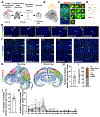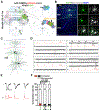Precise Long-Range Microcircuit-to-Microcircuit Communication Connects the Frontal and Sensory Cortices in the Mammalian Brain
- PMID: 31371111
- PMCID: PMC6813886
- DOI: 10.1016/j.neuron.2019.06.028
Precise Long-Range Microcircuit-to-Microcircuit Communication Connects the Frontal and Sensory Cortices in the Mammalian Brain
Abstract
The frontal area of the cerebral cortex provides long-range inputs to sensory areas to modulate neuronal activity and information processing. These long-range circuits are crucial for accurate sensory perception and complex behavioral control; however, little is known about their precise circuit organization. Here we specifically identified the presynaptic input neurons to individual excitatory neuron clones as a unit that constitutes functional microcircuits in the mouse sensory cortex. Interestingly, the long-range input neurons in the frontal but not contralateral sensory area are spatially organized into discrete vertical clusters and preferentially form synapses with each other over nearby non-input neurons. Moreover, the assembly of distant presynaptic microcircuits in the frontal area depends on the selective synaptic communication of excitatory neuron clones in the sensory area that provide inputs to the frontal area. These findings suggest that highly precise long-range reciprocal microcircuit-to-microcircuit communication mediates frontal-sensory area interactions in the mammalian cortex.
Keywords: columnar microcircuit; cortical circuit; excitatory neuron clone; in utero retroviral labeling; long-range circuit; quadruple whole-cell recording; rabies virus tracing; top-down modulation.
Copyright © 2019 Elsevier Inc. All rights reserved.
Conflict of interest statement
DECLARATION OF INTERESTS
The authors declare no competing financial interests.
Figures








Similar articles
-
Connectivity of mouse somatosensory and prefrontal cortex examined with trans-synaptic tracing.Nat Neurosci. 2015 Nov;18(11):1687-1697. doi: 10.1038/nn.4131. Epub 2015 Oct 12. Nat Neurosci. 2015. PMID: 26457553 Free PMC article.
-
Hippocampal and thalamic afferents form distinct synaptic microcircuits in the mouse infralimbic frontal cortex.Cell Rep. 2021 Oct 19;37(3):109837. doi: 10.1016/j.celrep.2021.109837. Cell Rep. 2021. PMID: 34686328
-
Ipsilateral cortical inputs to the rostral and caudal motor areas in rats.J Comp Neurol. 2016 Oct 15;524(15):3104-23. doi: 10.1002/cne.24011. Epub 2016 Apr 14. J Comp Neurol. 2016. PMID: 27037503
-
Input prediction and autonomous movement analysis in recurrent circuits of spiking neurons.Rev Neurosci. 2003;14(1-2):5-19. doi: 10.1515/revneuro.2003.14.1-2.5. Rev Neurosci. 2003. PMID: 12929914 Review.
-
Local connections of excitatory neurons in motor-associated cortical areas of the rat.Front Neural Circuits. 2013 May 28;7:75. doi: 10.3389/fncir.2013.00075. eCollection 2013. Front Neural Circuits. 2013. PMID: 23754982 Free PMC article. Review.
Cited by
-
Ascertaining cells' synaptic connections and RNA expression simultaneously with barcoded rabies virus libraries.Nat Commun. 2022 Nov 16;13(1):6993. doi: 10.1038/s41467-022-34334-1. Nat Commun. 2022. PMID: 36384944 Free PMC article.
-
Burst-dependent synaptic plasticity can coordinate learning in hierarchical circuits.Nat Neurosci. 2021 Jul;24(7):1010-1019. doi: 10.1038/s41593-021-00857-x. Epub 2021 May 13. Nat Neurosci. 2021. PMID: 33986551
-
Complicated architecture of cortical microcircuit: a comprehensive review.Anat Sci Int. 2025 Aug 20. doi: 10.1007/s12565-025-00877-8. Online ahead of print. Anat Sci Int. 2025. PMID: 40833717 Review.
-
Layer-Specific Connectivity and Functional Interference of Chrna2+ Layer 5 Martinotti Cells in the Primary Motor Cortex.Eur J Neurosci. 2025 Apr;61(7):e70086. doi: 10.1111/ejn.70086. Eur J Neurosci. 2025. PMID: 40170286 Free PMC article.
-
Interstitial Axon Collaterals of Callosal Neurons Form Association Projections from the Primary Somatosensory to Motor Cortex in Mice.Cereb Cortex. 2021 Oct 1;31(11):5225-5238. doi: 10.1093/cercor/bhab153. Cereb Cortex. 2021. PMID: 34228058 Free PMC article.
References
-
- Aronoff R, Matyas F, Mateo C, Ciron C, Schneider B, and Petersen CC (2010). Long-range connectivity of mouse primary somatosensory barrel cortex. The European journal of neuroscience 31, 2221–2233. - PubMed
-
- Bloom JS, and Hynd GW (2005). The role of the corpus callosum in interhemispheric transfer of information: excitation or inhibition? Neuropsychology review 15, 59–71. - PubMed
-
- Buschman TJ, and Miller EK (2007). Top-down versus bottom-up control of attention in the prefrontal and posterior parietal cortices. Science 315, 1860–1862. - PubMed
Publication types
MeSH terms
Grants and funding
LinkOut - more resources
Full Text Sources
Molecular Biology Databases

